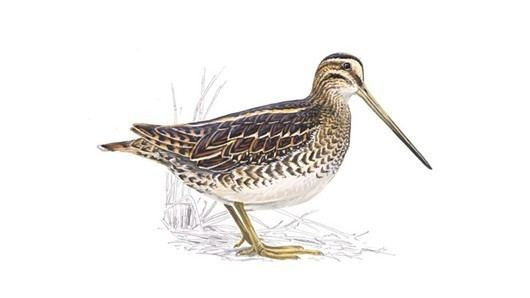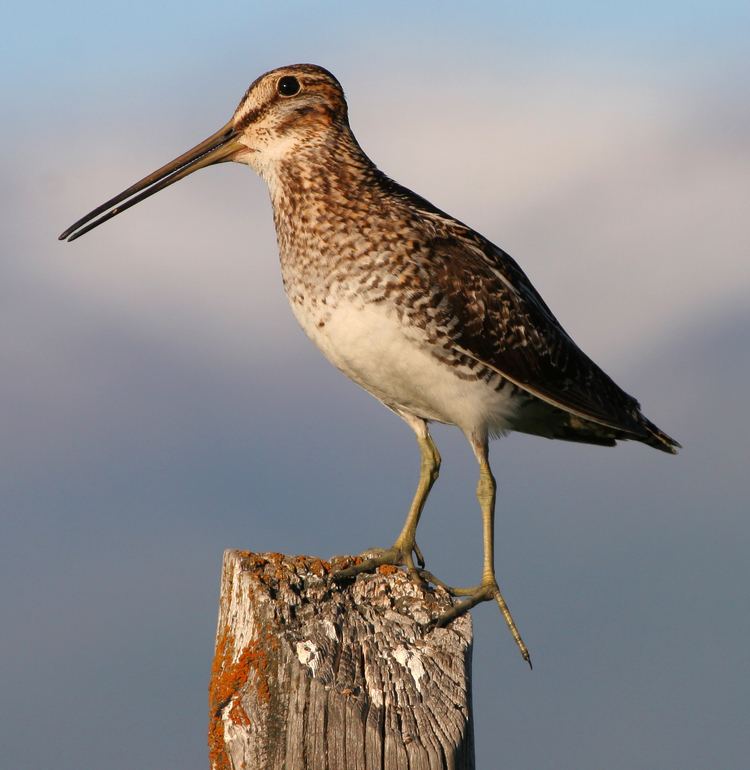Class Aves Family Scolopacidae | Phylum Chordata | |
 | ||
Length Common snipe: 25 – 27 cm, Jack snipe: 18 – 25 cm, Austral snipe: 19 – 24 cm Clutch size Common snipe: 4, Jack snipe: 3 – 4, Austral snipe: 2 Wingspan Common snipe: 44 – 47 cm, Jack snipe: 30 – 41 cm, Austral snipe: 28 – 35 cm Representative species Common snipe, Jack snipe, Wilson's snipe, Great snipe, Pin‑tailed snipe | ||
Bto bird id common and jack snipe
A snipe is any of about 25 wading bird species in three genera in the family Scolopacidae. They are characterized by a very long, slender bill and crypsis, or camouflage, plumage. The Gallinago snipes have a nearly worldwide distribution, the Lymnocryptes snipe is restricted to Asia and Europe and the Coenocorypha snipes are found only in the Outlying Islands of New Zealand. The three species of painted snipe are not closely related to the typical snipes, and are placed in their own family, the Rostratulidae.
Contents

Snipe hunt 2013 3
Behavior

Snipes search for invertebrates in the mud with a "sewing-machine" action of their long bills. The sensitivity of the bill, though to some extent noticeable in many sandpipers, is in snipes carried to an extreme by a number of filaments, belonging to the fifth pair of nerves, which run almost to the tip and open immediately under the soft cuticle in a series of cells. They give this portion of the surface of the premaxillaries, when exposed, a honeycomb-like appearance. Thus the bill becomes a most delicate organ of sensation, and by its means the bird, while probing for food, is at once able to distinguish the nature of the objects it encounters, though these are wholly out of sight.
Diet

Snipes feed mainly on insect larvae. Snipes also eat actual flies such as crane, horse and deer flies as well as beetles, dragonflies, crickets, grasshoppers, ants, mayflies, butterflies, caddisflies and moths. Other invertebrate prey include snails, crustaceans, and worms. The snipe's bill allows the very tip to remain closed while the snipe slurps up invertebrates.
Habitat

Snipes can be found in various types of wet marshy settings including bogs and swamps, wet meadows, and along rivers and ponds. Snipes avoid settling in areas with dense vegetation, but rather seek marshy areas with patchy cover to hide from predators.
Nesting
The female snipe makes a shallow hole in moist soil, and then weaves a grass lining to build a nest up to 7 inches across and 3 inches deep. A normal clutch size is 2–4 eggs, with an incubation period of 18–20 days. A snipe's eggs are typically an earthy brown colour with occasional blots of brown, black, or purple. Snipe chicks will usually leave the nest upon the first day of hatching.
Hunting
Camouflage may enable snipe to remain undetected by hunters in marshland. If the snipe flies, hunters have difficulty wing-shooting due to the bird's erratic flight pattern. The difficulties involved in hunting snipe gave rise to the term sniper, meaning a sharpshooter or someone who shoots from a hidden location.
"Going on a snipe hunt" is a phrase suggesting a fool's errand, or an impossible task. The snipe hunt is a practical joke in which an unsuspecting newcomer is led to an outdoor spot and instructed to hold a bag or pillowcase for catching "the snipe", and then is left "holding the bag" while the other group members disappear. As an American rite of passage, it is often associated with summer camps and groups such as the Boy Scouts.
